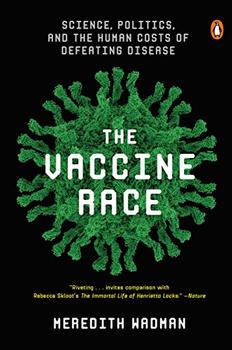Summary | Excerpt | Reviews | Beyond the Book | Readalikes | Genres & Themes | Author Bio

Critics' Opinion:
Readers' Opinion:
First Published:
Feb 2017, 448 pages
Paperback:
Sep 2018, 464 pages
 Book Reviewed by:
Book Reviewed by:
Zoë Fairtlough
Buy This Book
Prologue
The role of the infinitely small in nature is infinitely great.
—Louis Pasteur, nineteenth century French microbiologist
On October 9, 1964, a baby girl was born at Philadelphia General Hospital. She arrived early, when her mother was about thirty two weeks pregnant. The baby weighed 3.2 pounds and was noted to be blue, floppy, and not breathing. The only sign of life was her slow heartbeat. Nonetheless, she clung to life, and her seventeen year old mother named her.
One month later the baby was still in the hospital, and a doctor leaning close with a stethoscope heard a harsh heart murmur. A chest X ray showed that she had a massively enlarged heart because a hole in the muscular organ was preventing it from pumping blood efficiently. Doctors also noticed that the baby was staring into space, not fixing her gaze on anything. An ophthalmologist was called in. It emerged that the baby had cataracts blinding both eyes. Later other signs indicated that she was profoundly deaf, although a formal hearing test was never conducted.
In January 1965, after surgery attempting to repair one of the cataracts, the mother took her three month old daughter home. Nine days later the baby was back in the hospital with diarrhea. She remained in the hospital, where she suffered from recurring respiratory infections. She had trouble gaining weight, which is a common problem in infants with heart problems like hers. A psychologist who assessed her in July 1965, after a second heart defect was found, judged the nine month old to be the size of a two or three month old infant and at about that stage of development; she couldn't sit up or grasp an object placed in her hand.
The baby needed heart surgery if she was going to survive. Just before her first birthday, surgeons cut a seven inch incision in her chest wall and repaired her heart. After the operation she remained in the hospital. The chronic respiratory infections continued. The baby was sixteen months old and weighed eleven pounds when she died of pneumonia at 3:30 a.m. on February 18, 1966. She had lived all but nine days of her brief life at Philadelphia General Hospital.
The young mother had told the doctors something when she brought her daughter back to the hospital. When she was one month pregnant, she had had German measles, which is also known as rubella.
The early 1960s marked a coming of age for the study of viruses like the one that causes rubella—tiny infectious agents that invade cells and hijack their machinery in order to reproduce themselves. Biologists, with new tools in hand, were racing to capture viruses in throat swabs or urine or even snippets of organs from infected people and to grow them in lab dishes. Isolating a virus in the lab made it possible to make a vaccine against it. And making antiviral vaccines promised huge inroads against common childhood diseases like measles, mumps, and rubella, along with less common killers like hepatitis. The principle of vaccination is simple: if a person is injected with, or swallows, a tiny amount of a virus—either a killed virus or a weakened live virus—that person will develop antibodies against the virus. Then, if he or she is exposed in the future to the naturally occurring, disease causing form of the virus, those antibodies will attack the invader and prevent it from causing disease.
But if the concept is simple, making effective vaccines is anything but. In the early 1960s that reality was all too evident in recent tragedies. In 1942 as many as 330,000 U.S. servicemen were exposed to hepatitis B virus in a yellow fever vaccine that was contaminated with blood plasma from donors—plasma that was used to stabilize the vaccine. It turned out that some of those donors carried hepatitis B. About 50,000 of the vaccinated servicemen came down with the dangerous liver disease and between 100 and 150 died.3 In 1955 a California based company called Cutter Laboratories made polio vaccine with live, disease causing virus in it, paralyzing 192 people, many of them children, and killing ten. Every senior U.S. government employee involved in overseeing the Cutter process lost his or her job—right up through the director of the National Institutes of Health and the secretary of health, education, and welfare.
Excerpted from The Vaccine Race by Meredith Wadman. Copyright © 2017 by Meredith Wadman. Excerpted by permission of Viking. All rights reserved. No part of this excerpt may be reproduced or reprinted without permission in writing from the publisher.





The House on Biscayne Bay
by Chanel Cleeton
As death stalks a gothic mansion in Miami, the lives of two women intertwine as the past and present collide.

The Flower Sisters
by Michelle Collins Anderson
From the new Fannie Flagg of the Ozarks, a richly-woven story of family, forgiveness, and reinvention.

The Funeral Cryer by Wenyan Lu
Debut novelist Wenyan Lu brings us this witty yet profound story about one woman's midlife reawakening in contemporary rural China.
Your guide toexceptional books
BookBrowse seeks out and recommends the best in contemporary fiction and nonfiction—books that not only engage and entertain but also deepen our understanding of ourselves and the world around us.